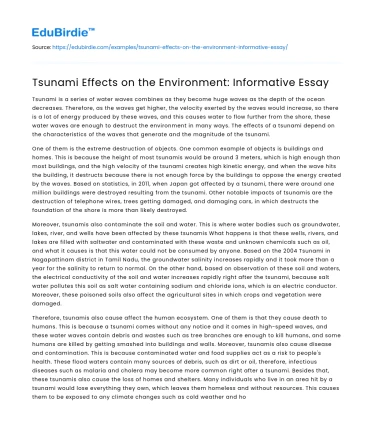Tsunami is a series of water waves combines as they become huge waves as the depth of the ocean decreases. Therefore, as the waves get higher, the velocity exerted by the waves would increase, so there is a lot of energy produced by these waves, and this causes water to flow further from the shore, these water waves are enough to destruct the environment in many ways. The effects of a tsunami depend on the characteristics of the waves that generate and the magnitude of the tsunami.
One of them is the extreme destruction of objects. One common example of objects is buildings and homes. This is because the height of most tsunamis would be around 3 meters, which is high enough than most buildings, and the high velocity of the tsunami creates high kinetic energy, and when the wave hits the building, it destructs because there is not enough force by the buildings to oppose the energy created by the waves. Based on statistics, in 2011, when Japan got affected by a tsunami, there were around one million buildings were destroyed resulting from the tsunami. Other notable impacts of tsunamis are the destruction of telephone wires, trees getting damaged, and damaging cars, in which destructs the foundation of the shore is more than likely destroyed.
Save your time!
We can take care of your essay
- Proper editing and formatting
- Free revision, title page, and bibliography
- Flexible prices and money-back guarantee
Moreover, tsunamis also contaminate the soil and water. This is where water bodies such as groundwater, lakes, river, and wells have been affected by these tsunamis What happens is that these wells, rivers, and lakes are filled with saltwater and contaminated with these waste and unknown chemicals such as oil, and what it causes is that this water could not be consumed by anyone. Based on the 2004 Tsunami in Nagapattinam district in Tamil Nadu, the groundwater salinity increases rapidly and it took more than a year for the salinity to return to normal. On the other hand, based on observation of these soil and waters, the electrical conductivity of the soil and water increases rapidly right after the tsunami, because salt water pollutes this soil as salt water containing sodium and chloride ions, which is an electric conductor. Moreover, these poisoned soils also affect the agricultural sites in which crops and vegetation were damaged.
Therefore, tsunamis also cause affect the human ecosystem. One of them is that they cause death to humans. This is because a tsunami comes without any notice and it comes in high-speed waves, and these water waves contain debris and wastes such as tree branches are enough to kill humans, and some humans are killed by getting smashed into buildings and walls. Moreover, tsunamis also cause disease and contamination. This is because contaminated water and food supplies act as a risk to people's health. These flood waters contain many sources of debris, such as dirt or oil, therefore, infectious diseases such as malaria and cholera may become more common right after a tsunami. Besides that, these tsunamis also cause the loss of homes and shelters. Many individuals who live in an area hit by a tsunami would lose everything they own, which leaves them homeless and without resources. This causes them to be exposed to any climate changes such as cold weather and hot weather and have no cover for them.
Moreover, tsunamis also cause the destruction of forests. Due to the fast water waves of the tsunami, these trees were snapped, uprooted, and undermined. Based on the 2004 Indian Ocean tsunami, natural forests were reduced by 8 percent due to this tsunami. Moreover, trees play a vital role in trapping carbon dioxide for photosynthesis. With these trees being reduced, carbon dioxide would not be trapped and therefore increasing carbon dioxide content on the earth and causing global warming
Not only do tsunamis affect humans, but they also affect marine life. How this affects is, these water waves mix with dirt and debris and accumulate in the river or lake. What happens is that the sunlight could not penetrate the water, causing the turbidity of the water to increase. When the turbidity increases, the oxygen content in the water decreases because the aquatic plants are unable to perform photosynthesis and unable to release oxygen in the water, therefore, killing these fish and the marine ecosystem. Therefore, these toxins and chemicals from the land are pushed to the river or lake by the tsunami and it does disrupt the food chain of the marine ecosystem and end up killing them.
References
- 1. Rensch, E. (2019, January 10). How Do Tsunamis Affect Human Lives? Retrieved March 1, 2019, from https://sciencing.com/do-tsunamis-affect-human-lives-8759187.html
- Impact of the December 2004 Tsunami on Soil, Groundwater and Vegetation in the Nagapattinam District, India. (2009, June 21). Retrieved March 1, 2019, from https://www.sciencedirect.com/science/article/pii/S0301479709001881
- Tsunamis: The Effects. (n.d.). Retrieved March 1, 2019, from https://www.sms-tsunami-warning.com/pages/tsunami-effects#.XHjE7ogza00
- Gilhooly, R. (n.d.). Tsunami-Hit Towns Face Dire Future. Retrieved March 1, 2019, from https://www.japantimes.co.jp/news/2011/04/01/national/tsunami-hit-towns-face-dire-future/
- Effects on Marine Life. (n.d.). Retrieved March 1, 2019, from http://tsunamisandmarinelife.weebly.com/effects-on-marine-life.html
- Tsunami Destruction and Reconstruction. (2009, March 21). Retrieved March 1, 2019, from https://kuruppukanda.wordpress.com/videos-photos/tsunami-destruction-and-reconstruction/






 Stuck on your essay?
Stuck on your essay?

